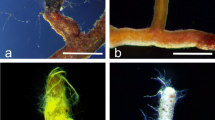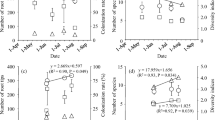Abstract
This work was aimed at understanding how the functional diversity of ectomycorrhizas (ECM) is driven by environmental factors and how it adapts to the structure of the forest stand. Superficial fine roots were sampled 21 times during an entire year in two adjacent plots (no thinning and strong thinning) of a mature beech (Fagus silvatica) forest. Individual ectomycorrhizal root tips were morphologically characterised and the symbiotic fungi were molecularly identified. ECM were also tested for dehydrogenase and acid phosphatase activities, and soil moisture and temperature were recorded. The results provide a description of ECM community dynamics over a whole year in the two stands. The main conclusions are threefold: (1) the species structure of the ECM community and metabolic activity of each morphotype change depending on the season, temperature and soil moisture, and a number of morphotypes are more abundant and active in winter than in summer, (2) the silviculture treatment (strong thinning) modifies the ectomycorrhizal community structure, and (3) the overall function of the ECM community results from the individual time pattern and specialisation of each morphotype.







Similar content being viewed by others
References
Agerer R (1987–1998) Colour atlas of ectomycorrhizae. Einhorn-Verlag Eduard Dietenberger, Munich
Agerer R (1995) Anatomical characteristics of identified ectomycorrhizas: an attempt towards a natural classification. In: Varma A, Hock B (eds) Mycorrhiza. Springer, Berlin Heidelberg New York
Agerer R, Taylor AFS, Treu R (1998) Effect of acid irrigation and liming on the production of fruit bodies by ecto-mycorrhizal fungi. Plant Soil 199:83–89
Aussenac G, Granier A (1988) Effects of thinning on water stress and growth in Douglas-fir. Can J For Res 18:100–105
Aussenac G, Granier A, Breda N (1995) Effets des modifications de la structure du couvert forestier sur le bilan hydrique, l’état hydrique des arbres et la croissance. Rev For Fr 47:54–62
Baar J, Horton TR, Kretzer A, Bruns, TD (1999) Mycorrhizal recolonization of Pinus muricata from resistant propagules after a stand-replacing wildfire. New Phytol 143:409–418
Bakker MR, Garbaye J, Nys C (2000) Effect of liming on the ectomycorrhizal status of oak. For Ecol Manage 126:121–131
Baxter JW, Dighton J (2001) Ectomycorrhizal diversity alters growth and nutrient acquisition of grey birch (Betula populifolia) seedlings in host-symbiont culture conditions. New Phytol 152:139–149
Baxter JW, Picket STA, Carriero MM, Dighton J (1999) Ectomycorrhizal diversity and community structure in oak forest stands exposed to contrasting anthropogenic impacts. Can J Bot 77:771–782
Blaise T, Garbaye J (1983) Effets de la fertilisation minérale sur les ectomycorhizes d’une hêtraie. Acta Oecol 4:165–169
Breda N, Granier A, Barataud F, Moyne C (1995) Soil water dynamics in an oak stand. Plant Soil 172:17–27
Bruns TD (1995) Thoughts on the processes that maintain local species diversity of ectomycorrhizal fungi. Plant Soil 170:63–73
Bruns TD, Szaro TM, Gardes M, Cullings KW, Pan JJ, Taylor DL, Horton TR, Kretzer A, Garbelotto M, Li Y (1998) A sequence database for the identification of ectomycorrhizal Basidiomycetes by phylogenetic analysis. Mol Ecol 7:257–272
Byrd KB, Parker VT, Vogler D, Cullings KW (2000) The influence of clear-cutting on ectomycorrhizal fungus diversity in a lodgepole pine (Pinus contorta) stand, Yellowstone National Park, Wyoming, and National Forest, Montana. Can J Bot 78:149–156
Dahlberg A (2001) Community ecology of ectomycorrhizal fungi: an advancing interdisciplinary field. New Phytol 150:555–562
Dickie IA, Xu B, Koide RT (2002) Vertical niche differentiation of ectomycorrhizal hyphae in soil as shown by T-RFLP analysis. New Phytol 156:527–535
Dighton J, Skeffington RA (1987) Effects of artificial acid precipitation on the mycorrhizas of Scots pine seedlings. New Phytol 107:191–202
Dormaar JF, Johnton A, Smoliak S (1984) Seasonal changes in carbon content and dehydrogenase, phosphatase, and urease activities in mixed prairie and fescue grassland Ah horizons. J. Range Manage 37:31–35
Dunigan D, Waters SB, Owen TC (1995) Aqueous soluble tetrazolium/formazan MTS as an indicator of NADH- and NADPH- dependent activity. Biotechniques 19:640–649
Eleanor MB, Lewis DH (1973) Surface phosphatase activity of mycorrhizal roots of beech. Soil Biol Biochem 5:249–257
Erland S, Finlay RD (1992) Effects of temperature and incubation time on the ability of three ecto-mycorrhizal fungi to colonise Pinus sylvestris roots. Mycol Res 96:270–272
Erland S, Taylor AFS (2002) Diversity of ecto-mycorrhizal fungal communities in relation to the abiotic environment. In: van der Heijden MGA, Sanders I (eds) Mycorrhizal ecology. Ecological Studies. Springer, Berlin Heidelberg New York, pp 163–200
Fogel R (1980) Mycorrhizae and nutrient cycling in natural forest ecosystems. New Phytol 86:199–212
Garbaye J, Guehl JM (1997) Le rôle des ectomycorhizes dans l’utilisation de l’eau par les arbres forestiers. Rev For Fr 49:110–120
Gardes M, Bruns TD (1993) ITS primers with enhanced specificity for basidiomycetes—application to the identification of mycorrhizae and rusts. Mol Ecol 2:113–118
Gardes M, Bruns TD (1996) Community structure of ectomycorrhizal fungi in a Pinus muricata forest: above- and below-ground views. Can J Bot 74:1572–1583
Goodman DM, Trofymow JA (1998) Comparison of communities of ectomycorrhizal fungi in old-growth and mature stands of Douglas-fir at two sites on southern Vancouver Island. Can J For Res Rev Can Rech For 28:574–581
Hampp R, Schaeffer C (1995) Mycorrhiza—carbohydrates and energy metabolism. In: Varma AK, Hock B (eds) Mycorrhiza: structure, molecular biology and function. Springer, New York Berlin Heidelberg, pp 267–296
Hobbie EA, Weber NS, Trappe JM (2001a) Determining mycorrhizal or saprophitic status of fungi from isotopic evidence: implications for element cycling and fungal evolution. New Phytol 150:601–610
Hobbie EA, Weber NS, Trappe JM, van Klinken GJ (2001b) Using radiocarbon to determine the mycorrhizal status of fungi. New Phytol 156:129–136
Högberg P, Plamboeck AH, Taylor AFS, Fransson P (1999) Natural 13C abundance reveals trophic status of fungi and host-origin of carbon in mycorrhizal fungi in mixed forests. Proc Natl Acad Sci USA 96:8534–8539
Horton TR, Bruns TD (1998) Multiple host fungi are the most frequent and abundant ectomycorrhizal types in a mixed stand of Douglas fir (Pseudotsuga menziesii D. Don) and bishop pine (Pinus muricata D. Don). New Phytol 139:331–339
Horton TR, Bruns TD (2001) The molecular revolution in ectomycorrhizal ecology: peeking into the black-box. Mol Ecol 10:1855–1871
Ivarson KL, Sowden FJ (1970) Effect of frost action and storage of soil at freezing temperatures on the free amino acids, free sugars and respiratory activity of soil. Can J Soil Sci 57:205–215
Jany JL, Garbaye J, Martin F (2002) Cenococcum geophilum populations show a high degree of genetic diversity in beech forests. New Phytol 154:651–659
Jany JL, Martin F, Garbaye J (2003) Respiration activity of ectomycorrhizas from Cenococcum geophilum and Lactarius sp. in relation to water potential in five beech forest. Plant Soil 255:487–494
Jonsson LM, Nilsson MC, Wardle DA, Zackrisson O (2001) Context dependent effects of ectomycorrhizal species richness on tree seedling productivity. Oikos 93:353–364
Koide RT, Shumway DL, Stevens CM (2000) Soluble carbohydrates of red pine (Pinus resinosa) mycorrhizas and mycorrhizal fungi. Mycol Res 104:834–840
Kranabetter JM, Wylie T (1998) Ectomycorrhizal community structure across forest opening on naturally regenerated western hemlock seedlings. Can J Bot 76:189–196
Le Goff N, Ottorini JM (1993) Thinning and climate effects on growth of beech (Fagus silvatica L.) in experimental stands. For Ecol Manage 62:1–14
Le Tacon F, Selosse MA, Gosselin F (2001) Biodiversité, fonctionnement des écosystèmes et gestion forestière. Deuxième partie: interventions sylvicoles et biodiversité. Rev For Fr 53:56–80
Lilleskov EA, Fahey TJ, Horton TR, Lovett GM (2002) Belowground ectomycorrhizal fungal community change over a nitrogen deposition gradient in Alaska. Ecology 83:104–115
Martin F (2001) Frontiers in molecular mycorrhizal research—genes, loci, dots and spins. New Phytol 150:499–505
Martin F, Ramstedt M, Söderhäll K (1987) Carbon and nitrogen metabolism in ectomycorrhizal fungi and ectomycorrhizas. Biochimie 69:569–581
McClaugherty CA, Linkins AE (1990) Temperature responses of enzymes in two forest soils. Soil Biol Biochem 22:29–33
Olsen SR, Sommers LE (1982) Phosphorus. In: Page AL (ed) Methods of soil analysis; part 2: Chemical and microbiological properties. American Society of Agronomy, Soil Science Society of America, Madison, Wis., p 403–430
Oswald H (1986) Le “carré latin” de Souilly: dispositif expérimental d’éclaircie du hêtre. Bull Soc For Franche-Comté vol 41:11–24
Peter M, Ayer F, Egli S (2001) Nitrogen addition in a Norway spruce stand altered macromycete sporocarp production and below-ground ectomycorrhizal species composition. New Phytol 149:311–325
Pigott CD (1982) Survival of mycorrhizas formed by Cenococcum geophilum Fr. in dry soils. New Phytol 92:513–517
Prévost A, Pargney JC (1995) Comparaison des ectomycorhizes naturelles entre le hêtre (Fagus silvatica) et deux lactaires (Lactarius blennius var viridis et Lactarius subdulcis). I. Caractéristiques morphologiques et cytologiques. Ann Sci For 52:131–146
Ramstedt M, Jirjis R, Söderhäll K (1987) Metabolism of mannitol in mycorrhizal and non-mycorrhizal fungi. New Phytol 105:281–287
Ross DJ (1970) Effects of storage on dehydrogenase activities of soil. Soil Biol Biochem 2:55–61
SAS Institute (1998) Using Statview, 2nd edn. SAS Institute, Cary, N.C.
Shi L, Guttenberger M, Kottke I, Hampp R (2002) The effect of drought on mycorrhizas of beech (Fagus sylvatica L.): changes in community structure, and content of carbohydrates and nitrogen storage bodies of the fungi. Mycorrhiza 12:303–311
Smith SE, Read DJ (1997) Mycorrhizal symbiosis, 2nd edn. Academic Press, London
Tedersoo L, Koljalg U, Hallenberg N, Larsson K-H (2003) Fine scale distribution of ectomycorrhizal fungi and roots across substrate layers including coarse woody debris in a mixed forest. New Phytol 159:153–165
Tibett M, Chambers SM, Cairney JWG (1998) Methods for determining extracellular and surface-bound phosphatase activities in ectomycorrhizal fungi. In: Varma A (ed) Mycorrhiza manual. Springer, Berlin Heidelberg New York, pp 217–226
Voiry H (1981) Classification morphologique des ectomycorhizes du chêne et du hêtre dans le nord-est de la France. Eur J For Pathol 11:284–299
Worley JF, Hacskaylo E (1959) The effects of available soil moisture on the mycorrhizal associations of Virginia pine. For Sci 5:267–268
Zolnai A, Toth B, Wilson RA, Frenyo VL (1998) Comparison of 3H-Thymidine incorporation and CellTiter 96 Aqueous colorimetric assays in cell proliferation of bovine mononuclear cells. Acta Vet Hung 46:191–197
Acknowledgements
This research was supported by the GIP ECOFOR (“Biodiversité et Gestion Forestière” programme). We would like to thank Drs. N. Le Goff and J.M. Ottorini (INRA Nancy, France) and the Verdun-Fresne division of the Office National des Forêts (ONF), for the authorisation to use the site of Souilly for this study. We also thank Drs. Francis Martin and Martina Peter (INRA Nancy) for critical reading of the manuscript and discussions, Dr. Benoît Marçais for his decisive help in statistical analysis, Christine Delaruelle (INRA Nancy) for her technical assistance in DNA sequencing and Jean-Pierre Maurice (AMYPHAR, Nancy, France) for the identification of fungal fruiting bodies.
Author information
Authors and Affiliations
Corresponding author
Rights and permissions
About this article
Cite this article
Buée, M., Vairelles, D. & Garbaye, J. Year-round monitoring of diversity and potential metabolic activity of the ectomycorrhizal community in a beech (Fagus silvatica) forest subjected to two thinning regimes. Mycorrhiza 15, 235–245 (2005). https://doi.org/10.1007/s00572-004-0313-6
Received:
Accepted:
Published:
Issue Date:
DOI: https://doi.org/10.1007/s00572-004-0313-6




